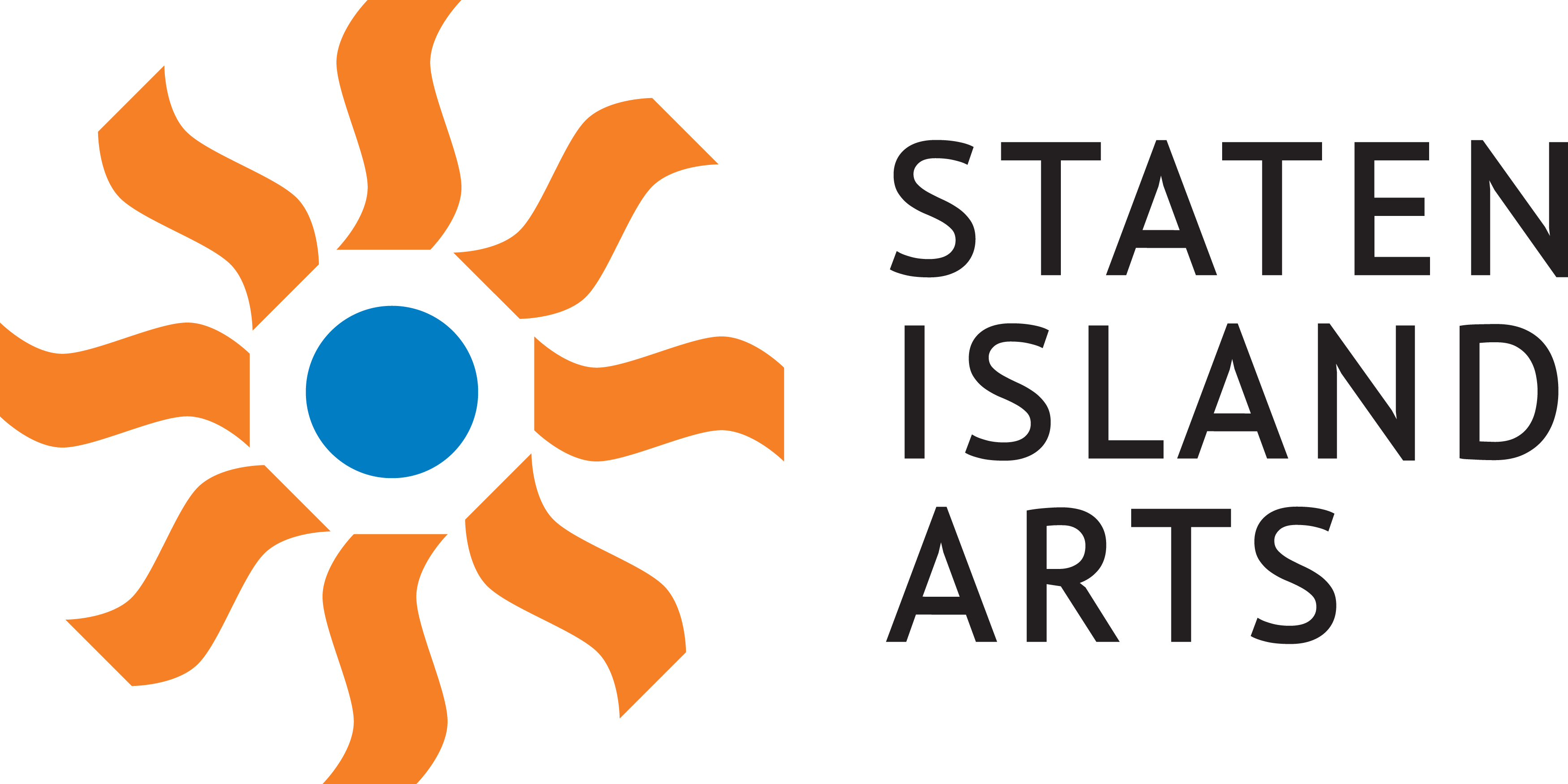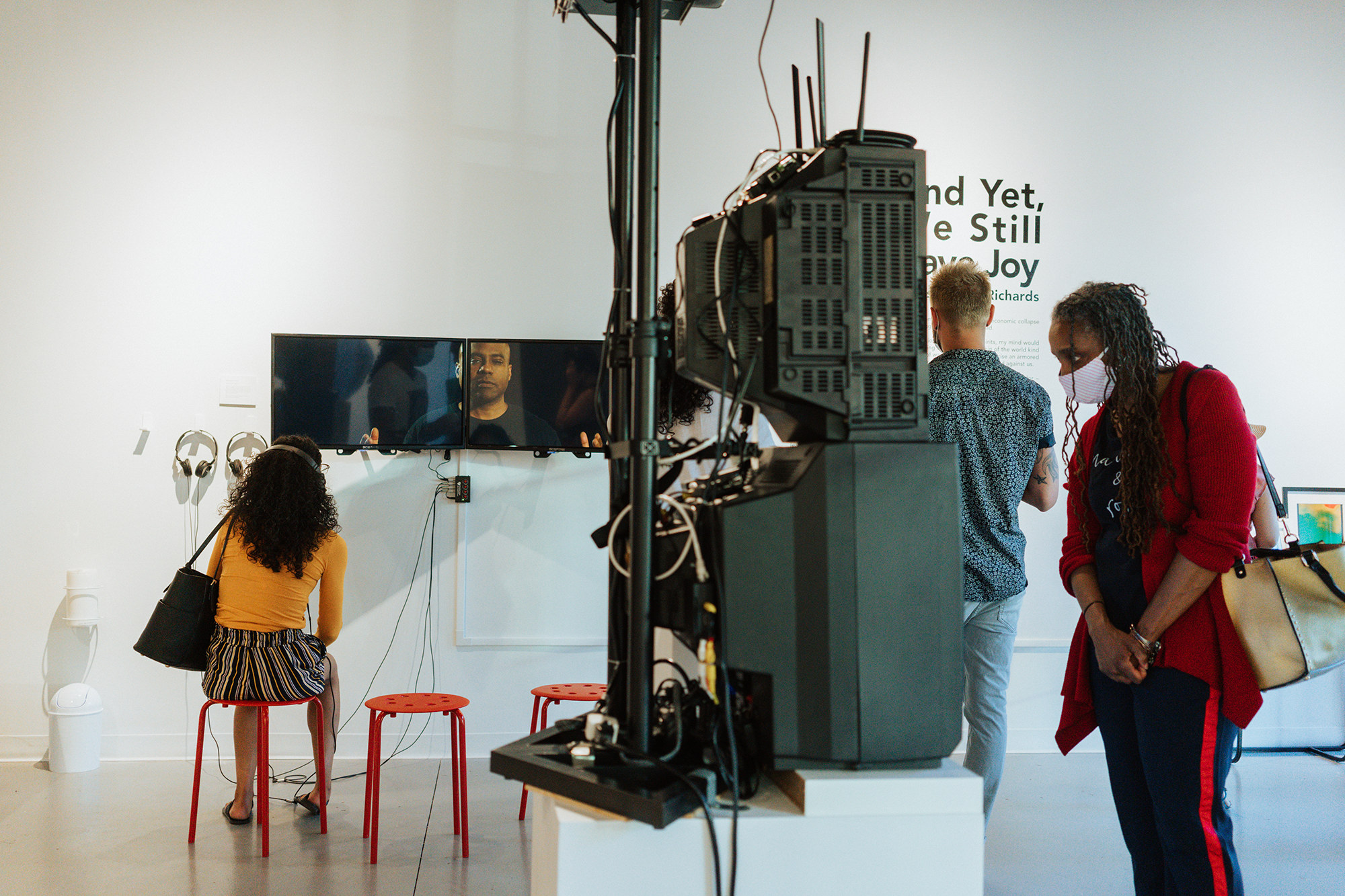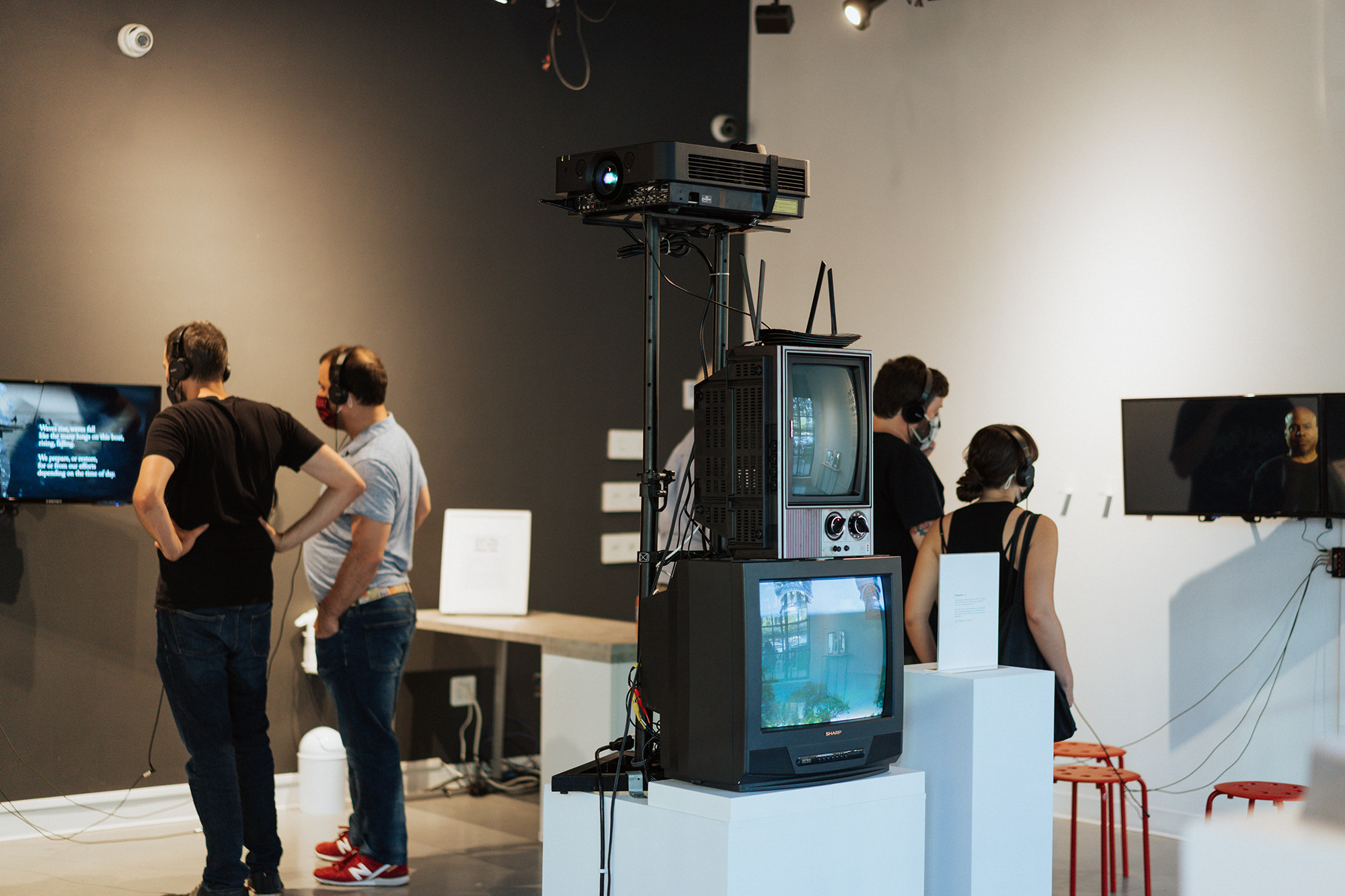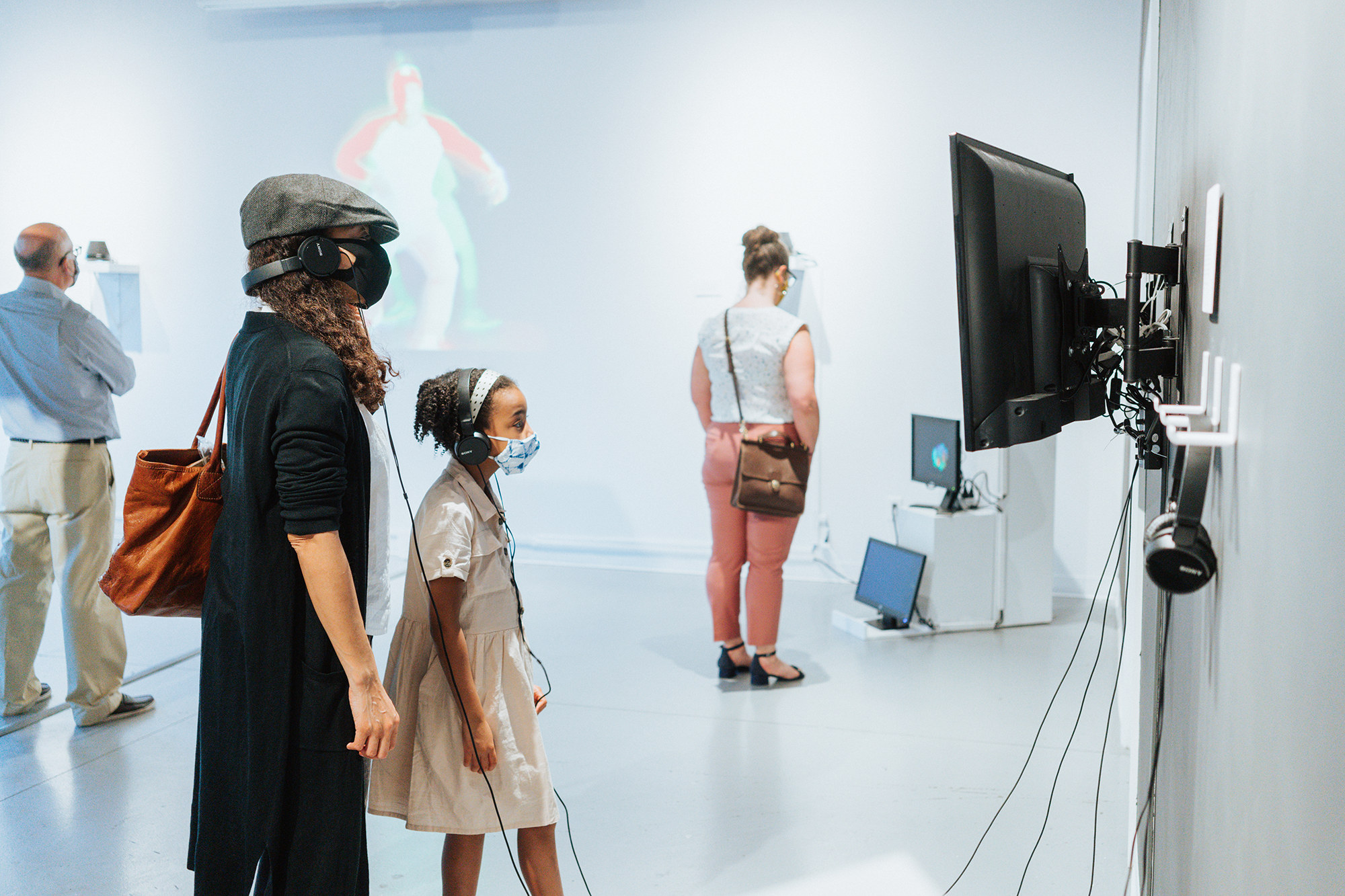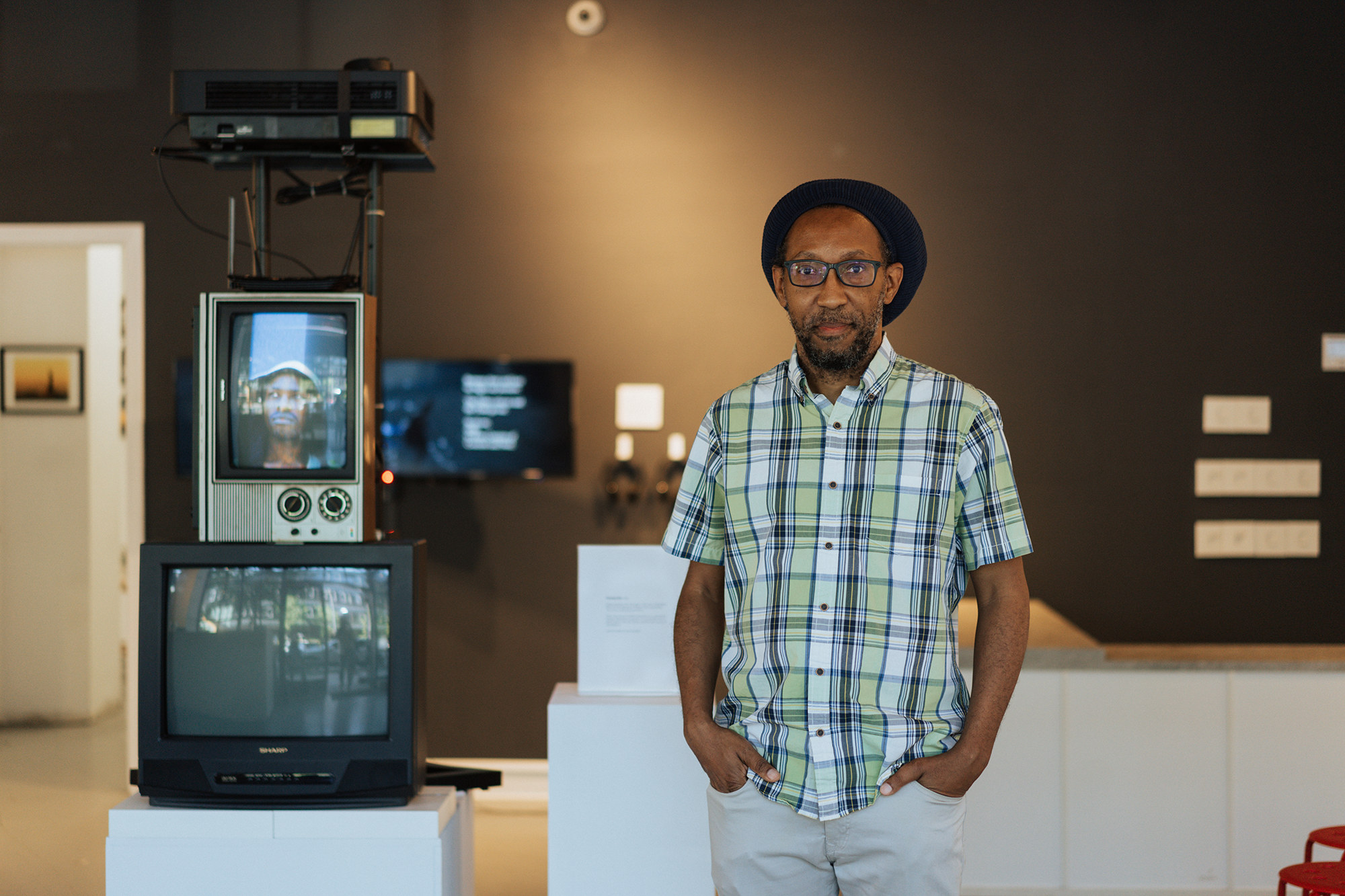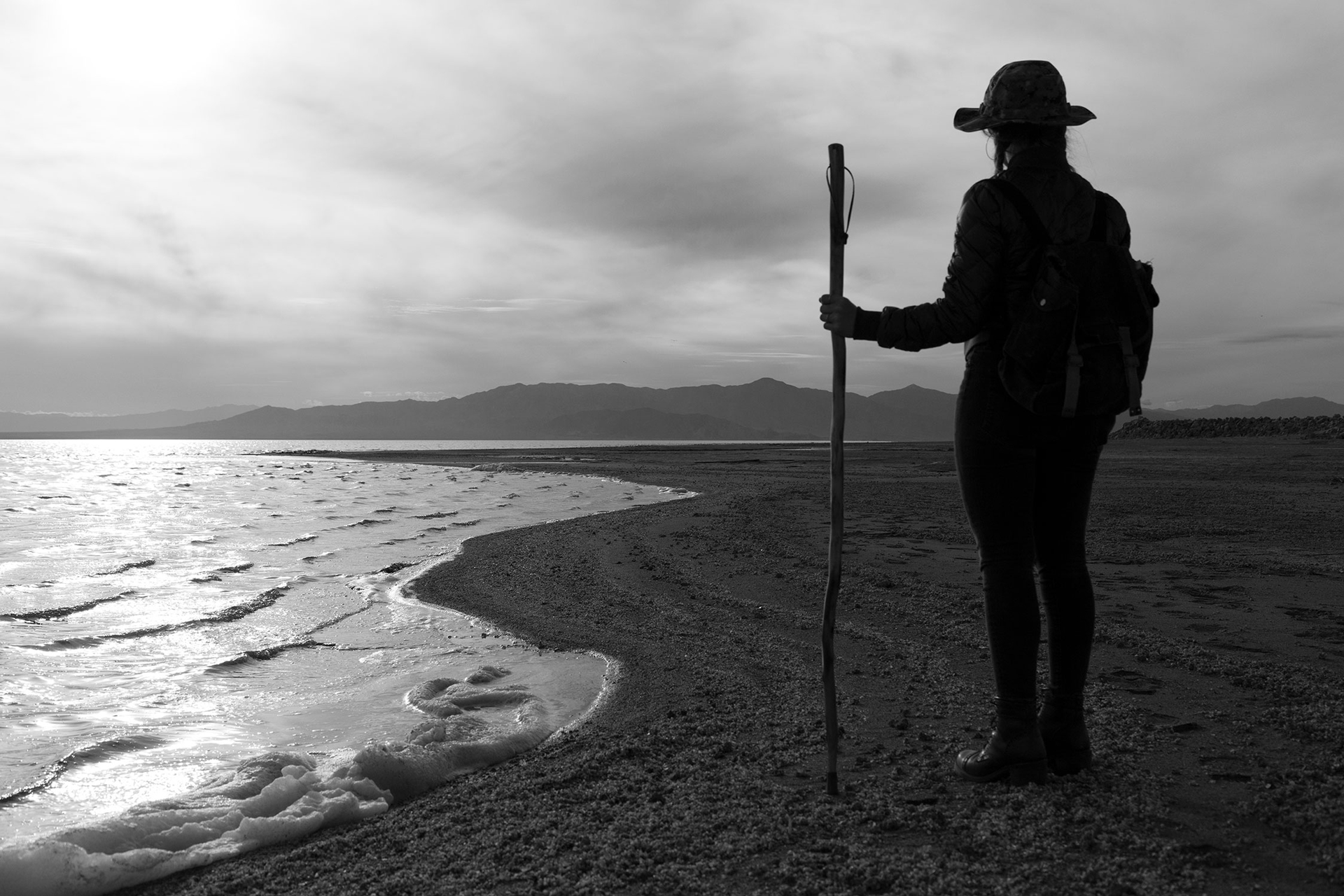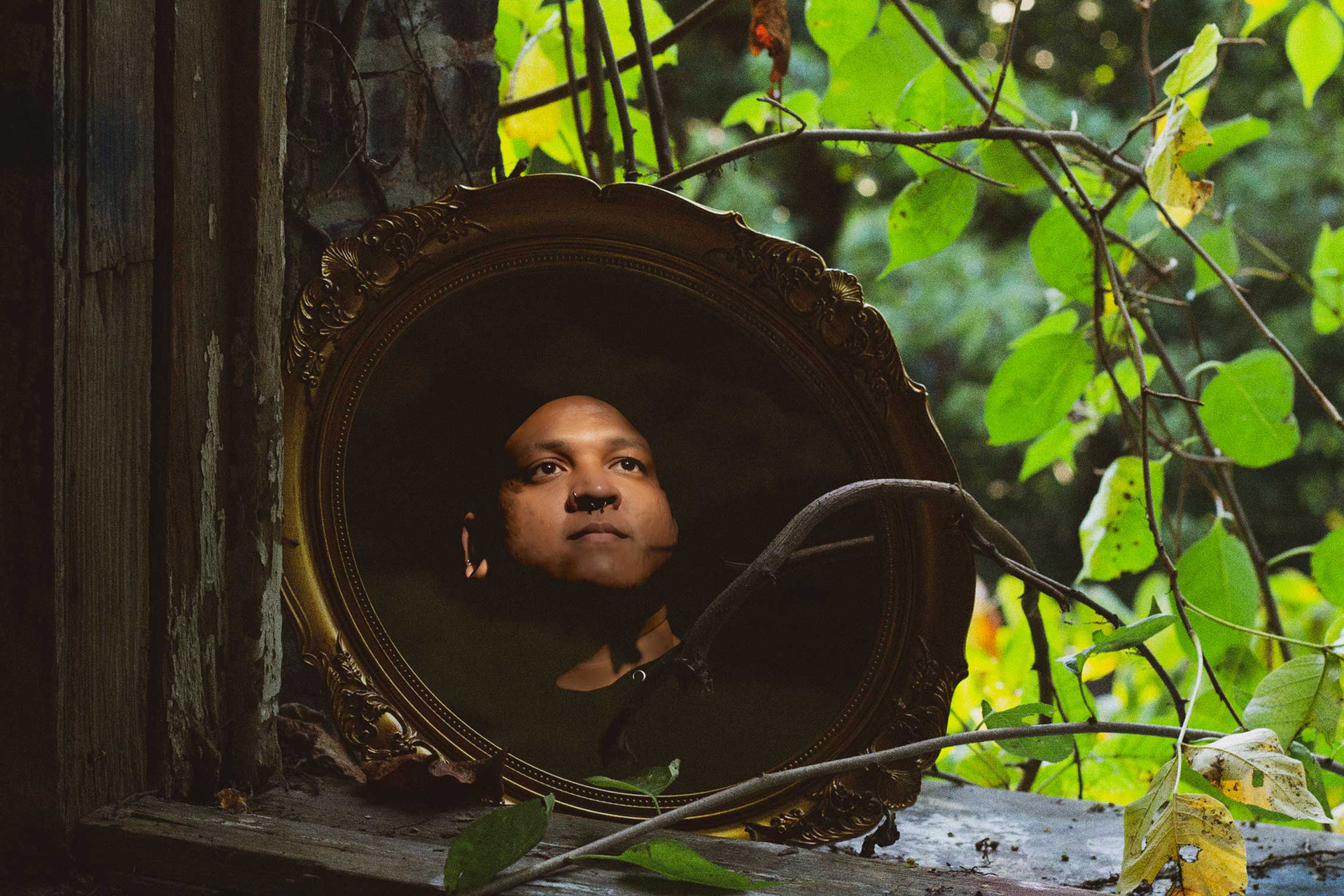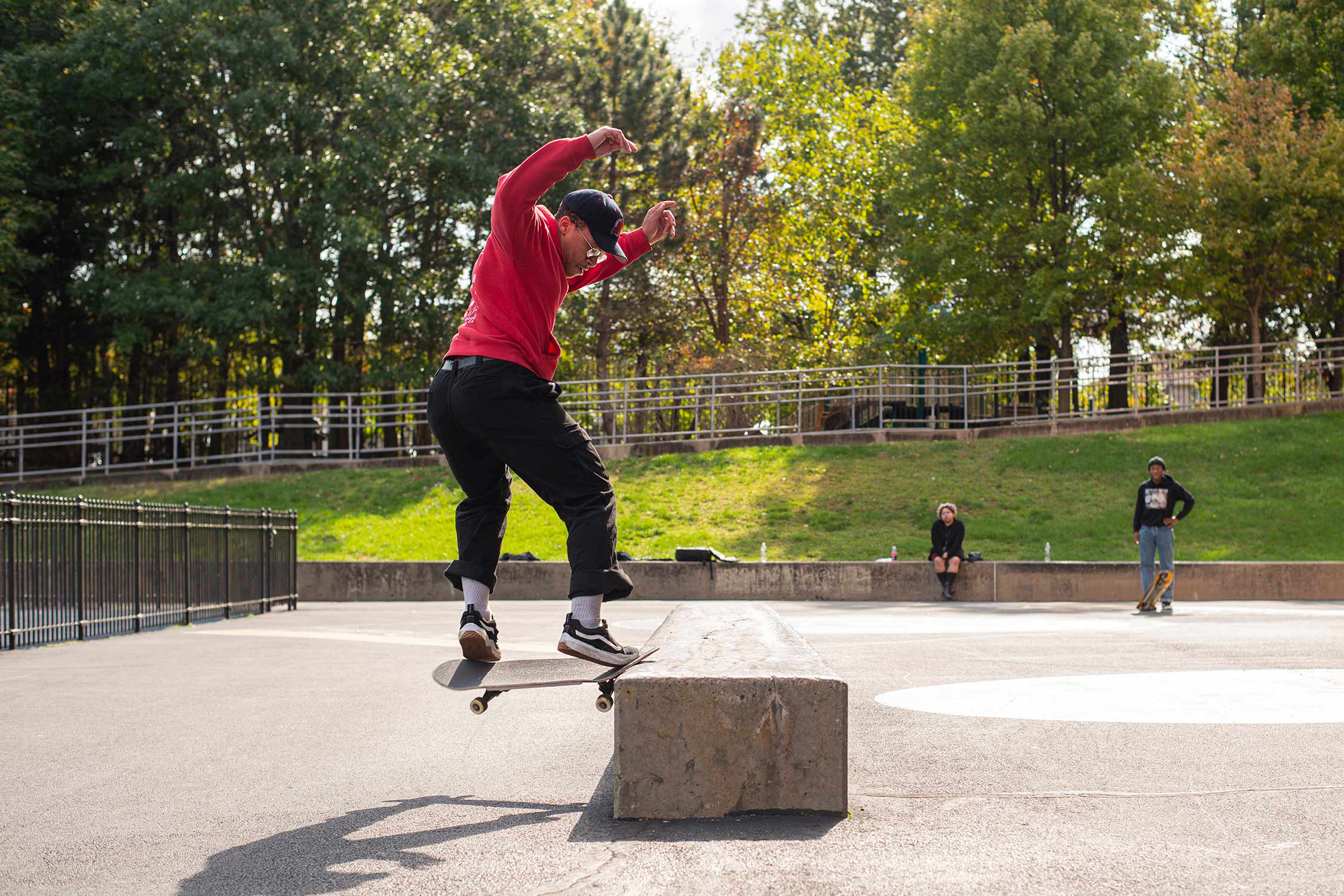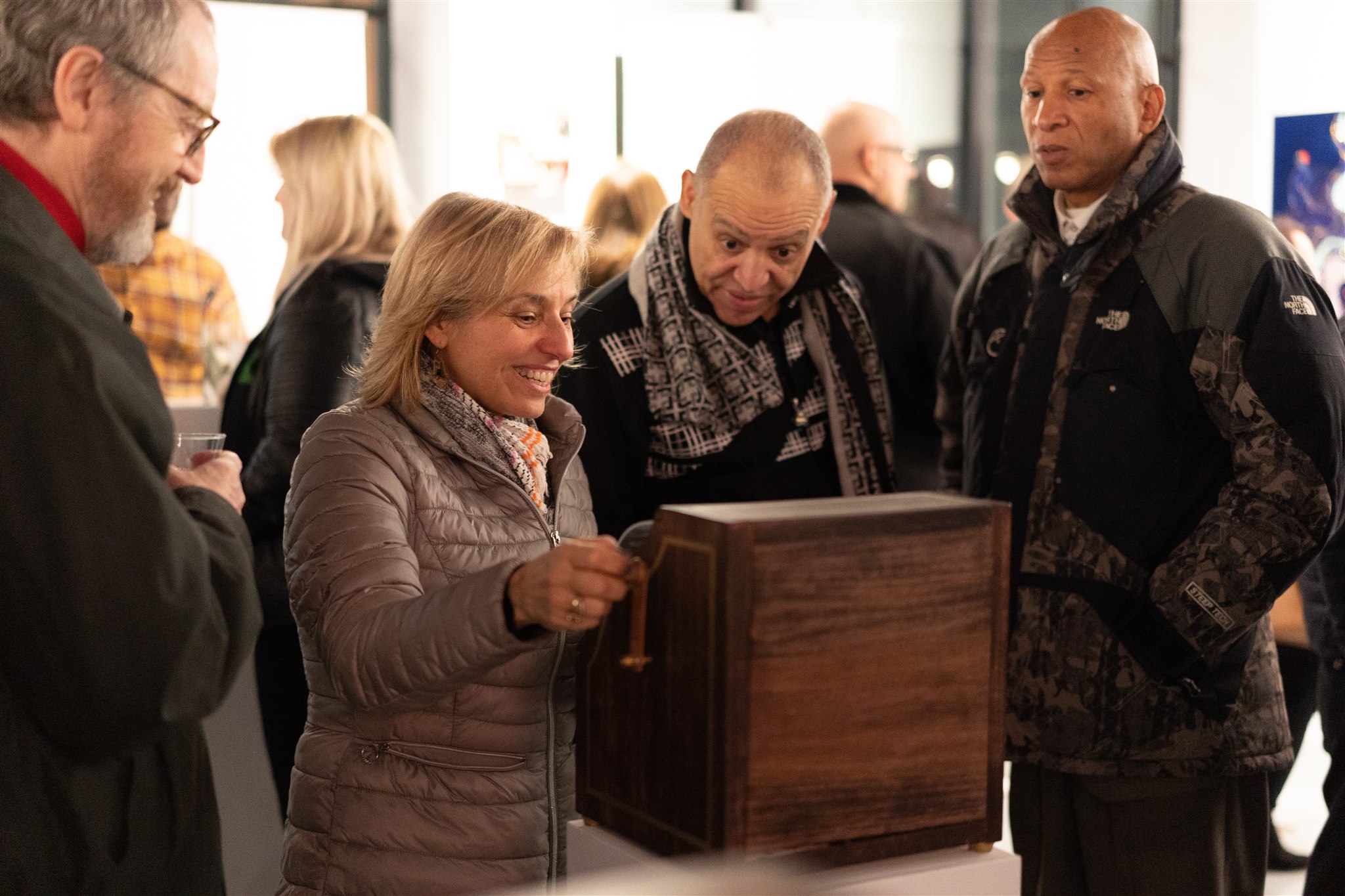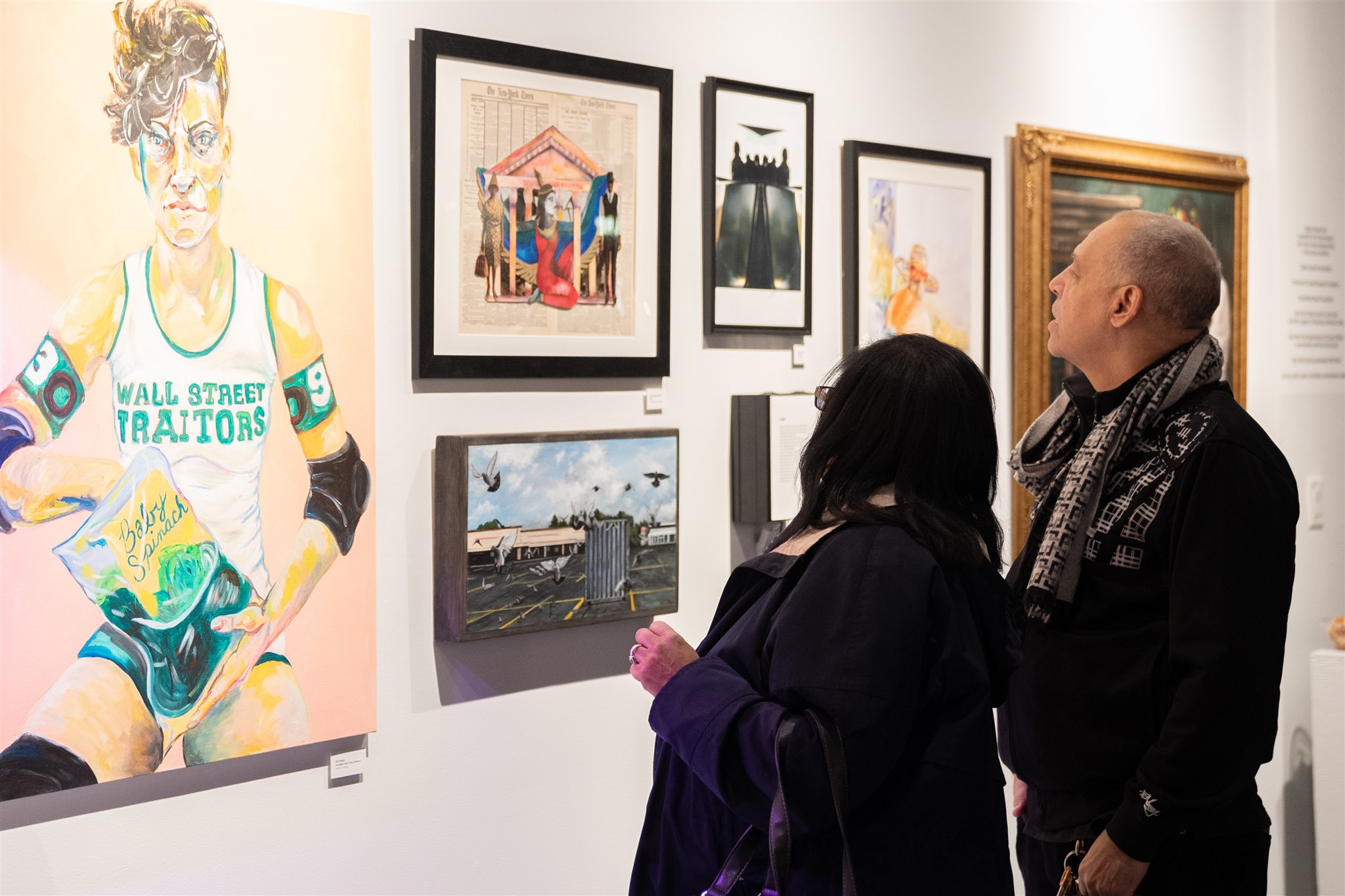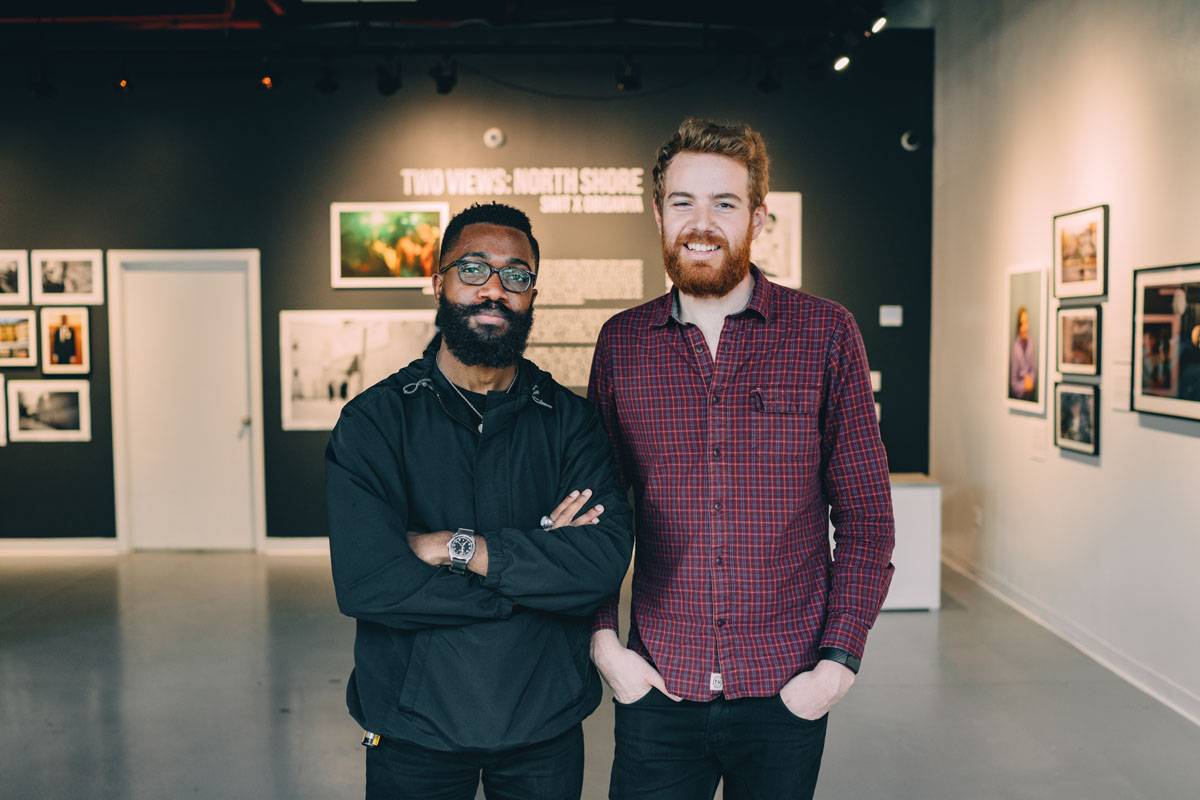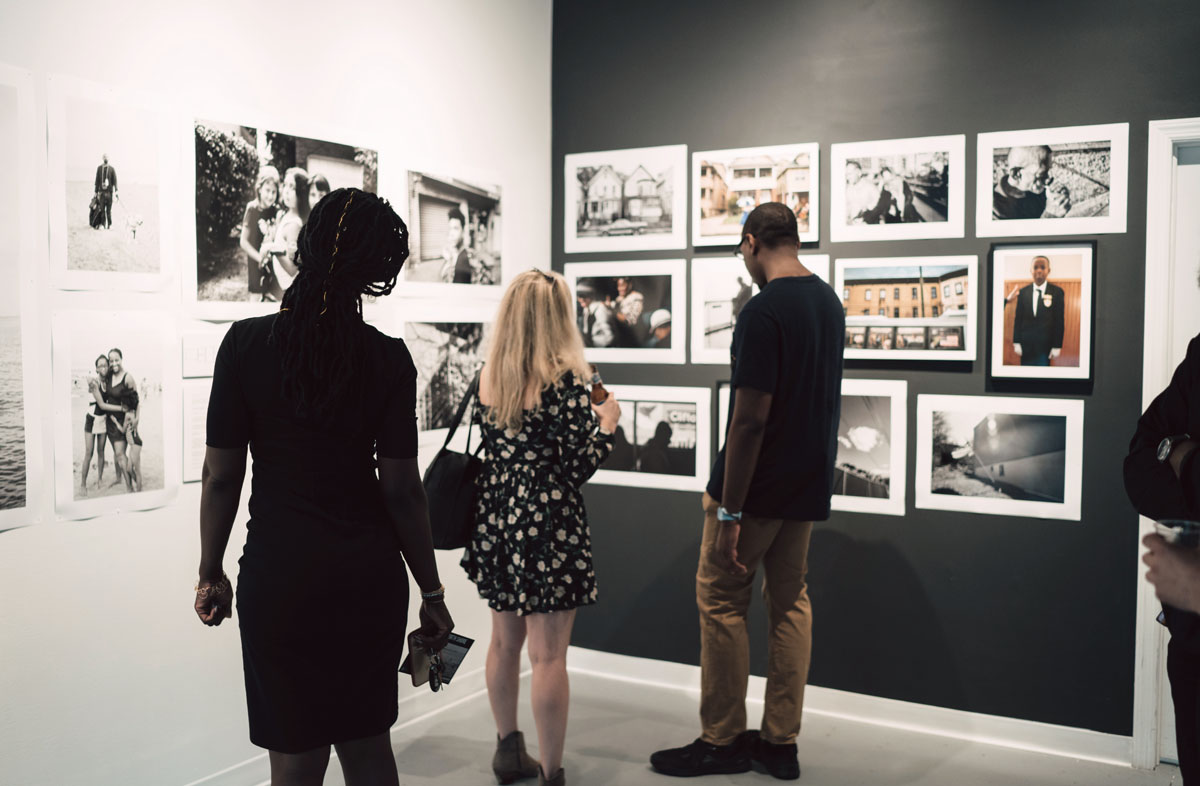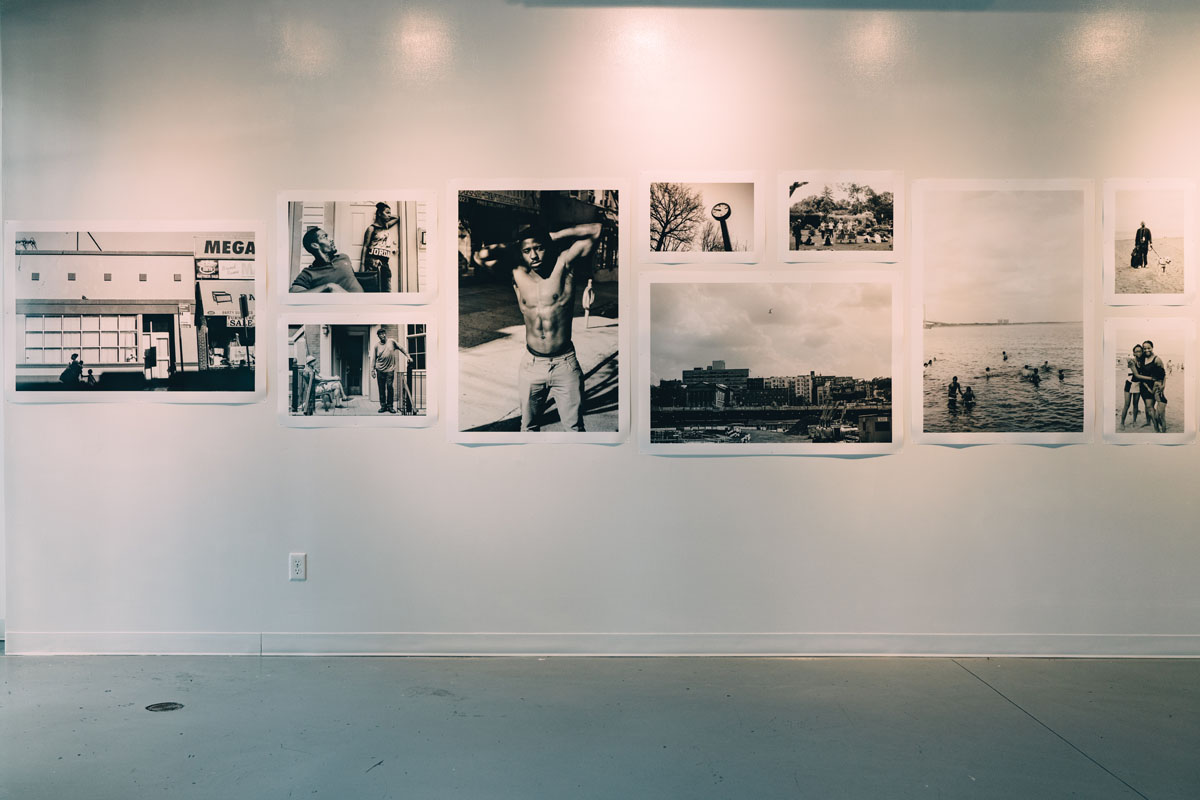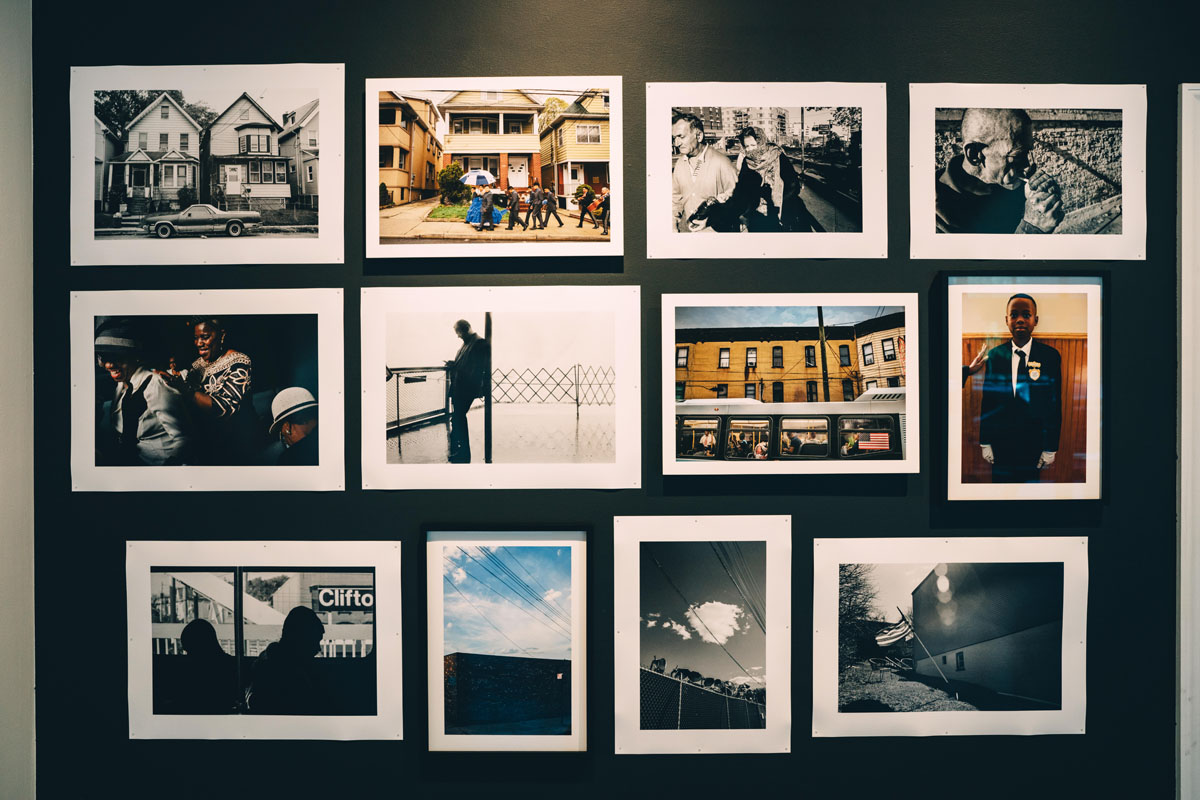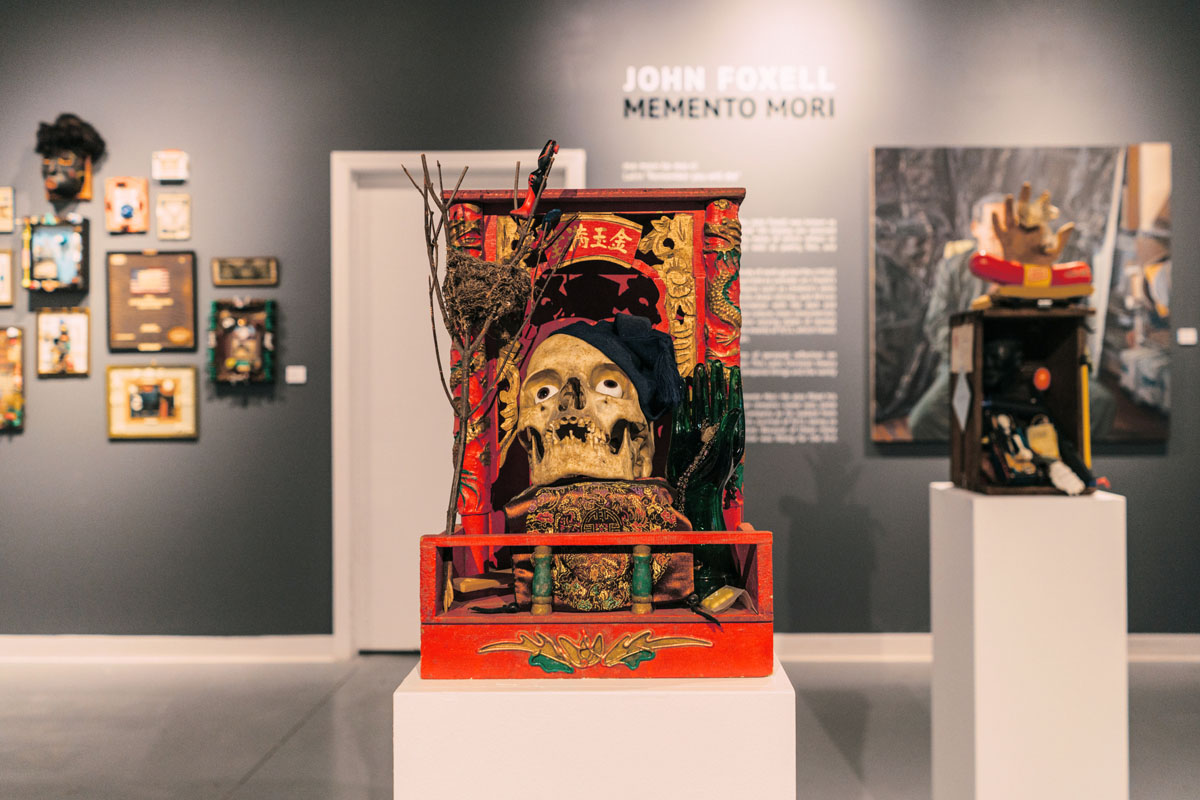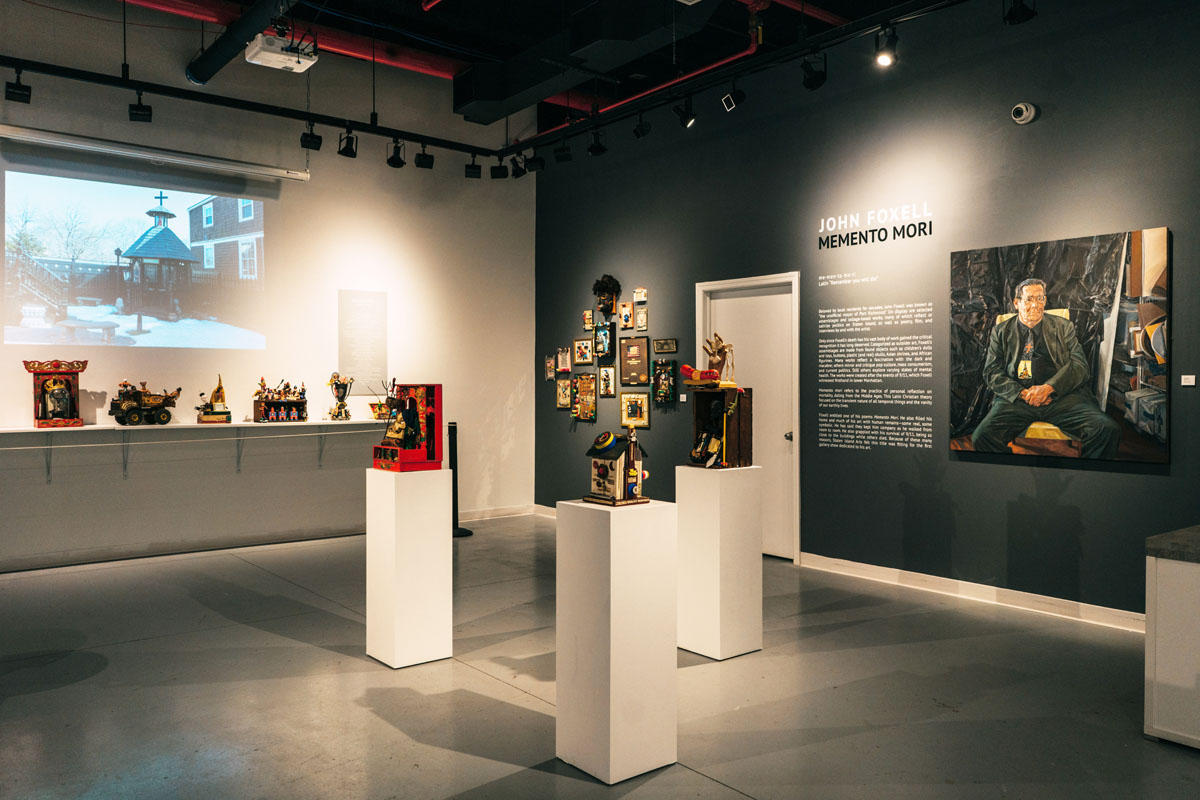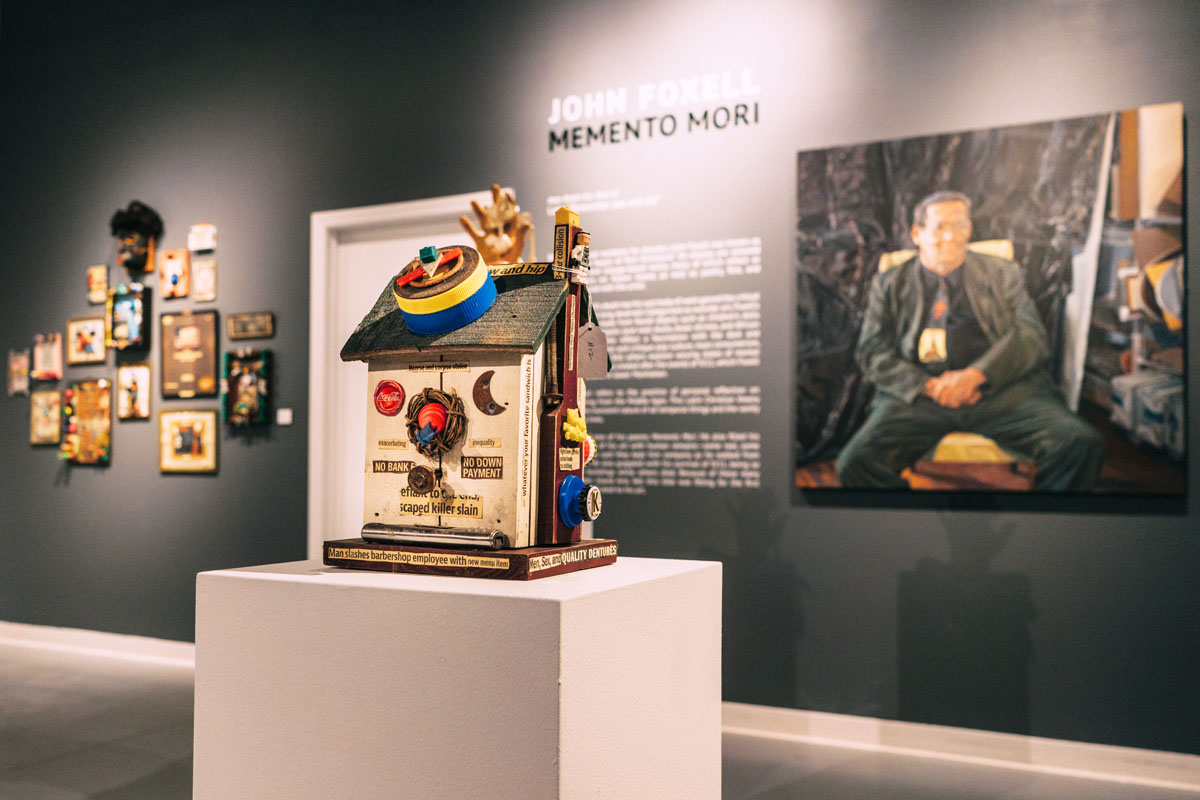And Yet, We Still Have Joy
And Yet, We Still Have Joy
June 17 through Sept 30, 2021
Photos by Amanda Domenech for Staten Island Arts
As James Francis Richards lived through 2020, from the pandemic to the economic collapse to the violence against Black people, he kept saying to himself – this is bad.
And then almost immediately, like an incantation to ward off evil spirits, my mind would reply “And yet, we still have joy.” Not in a trying to block out the pain of the world kind of way, but in a “This will not defeat us” kind of way. That we would exercise an armored joy, a joy that would give all the stamina needed to survive the forces allied against us.
In his first solo exhibit, Richards constructs a journey – through video, sound, and color – inviting us to travel from grief to joy.
He begins with portraits of lives lost, then shapes a path that incorporates sparring contemporary voices, historical reflections, abstractions of real and projected identity… then waves of color, kaleidoscopic experimentation, and finally, the electric euphoria of dance. His progression from diverse literal narratives to abstraction, color play, and expansive projection aims to carry participants to “eventually find themselves enraptured by color and sound. There is a language beyond language and these are some of my attempts to decipher it… an opportunity for the viewer to breathe out and allow color and light in.” Richards hopes one will leave with a sense of resiliency of the human spirit.
And Yet, We Still Have Joy is Richards’ personal disruption of the mainstream narrative. Working in film for almost thirty years, the vast majority of his efforts have been in service to others. “Video art is not new, but for a long time was dominated by people who had the means and opportunity to explore it. But lately there has been a blossoming of artists of color working in video from Arthur Jafa, to Kahil Joseph, to Garrett Bradley, to Mickalene Thomas. I wish to add my small voice to the growing choir.”
James Francis Richards
James Francis Richards (b. 1968) is a filmmaker, storyteller, and Projection Systems Supervisor at the Kanbar Institute of Film & TV, where he’s worked since 1998. Having touched nearly every aspect of the personal and professional film worlds—from production assistance and truck driving to overseeing cinematography, writing, and directing—Richards has built off his education at New York University’s Graduate Film Program to produce a variety of features, shorts, and collaborative works. For over two decades, his work has screened internationally and received critical acclaim.
Warm Tide tied for first in the short film competition at the Black Filmmakers Hall of Fame in Oakland in 1997. Bird Losing Feathers was nominated for Best Short at The Martha’s Vineyard African American Film Festival a year later. In 2006, Richards’ collaborative effort with peers from NYU, 6 Things I Never Told You, participated in the IFP Rough Cut Lab and later served as the inaugural film in the ACT NOW/New Voices in Black Cinema film series (BAM, 2009). In 2014, The Bicycle, won best feature film at the Newark Black Film Festival.
In addition to his own productions, Richards has served as a Co-organizer for The Obsidian Society’s Short Film Festival at the Schomburg Center in Harlem, as Curator for The Annual Emerging Black Filmmaker Festival at the Langston Hughes Community Library and Cultural Center, and Co-curator of The Leagues Film Showcase at New York University.
Know Me
Know Me
February 26 – May 31, 2021
Originally online at knowmeshow.org
Images cropped for this carousel
Featuring work by Kofi Antwi, Flint Gennari, Elvia Iannaccone Gezlev, Jessica L Gianna, Daniel Jared Smith, Windy Nicely, Laura Pannone, and Tabitha Lee Turchio.
Know Me was an exploration of identity through the eyes of eight Staten Island artists. The exhibit challenged viewers to consider the inner world of another, and the minute-by-minute decisions that, together as an evolving whole, create the story of one’s life. If you could do anything in your home or your neighborhood this Saturday, what would it be? What is the first thing you think of upon waking? Does it inspire you or bring you fear? Where do you go, in your head or your actions, to experience your greatest joy, expression, passion, or solace? What is the most important thing about you that most people don’t see? How do the way you walk, talk, dress, and adorn your body help define who you are? How does your past self collide with or complement your present self? What beliefs do you hold that inform almost every choice you make?
Each piece in Know Me urged the viewer to consider the selfhood of both the subjects in the piece as well as the artist choosing to create it. The phrase “know me” might be a request, a demand, or a question. While Staten Island is rich with diverse stories and creative energy, many worlds never overlap. A face may look familiar, but nothing more is known. How might our spheres grow closer? How might we collaborate if our shared passions were known?
Know Me? Know Me.
Dawn of a New Decade
Dawn of a New Decade
January 2020 through January 2021
Photos by Amanda Lee for Staten Island Arts
As the dawn of a new decade approached, we invited Staten Island artists to look back, or look forward. The last ten years brought unprecedented change. The next ten years promise more. We welcomed works from all artistic disciplines that examined the last decade or the one to come.
What we received was astounding, a spectrum of work as vast and diverse as the challenges and triumphs of the decade we have just shared. From the changing tides of Great Kills Park to Mile 7 in Ghana, from stunning still lifes to self-portraits to Safe Water, from Wall Street “traitors” to women and girls in graphite, paint, collage, and photography, we exhibited work of 32 artists.
Featuring Barbara Mattera Hoffman, Brandon Herman, Catherine Popov, Diane Matyas, Douglas La Tourette, Elzbieta Wysoczanska, Emily Perina, Emily Sarah Long, Harry Magzul, Isaac Grant, Jessica Lauser, Judith Hugentobler, Keri Sheheen, Kevin Barker-Herod, KLeyko, Lance J. Reha, Lea Simoniello, Len Rachlin, Lenny Librizzi, Mae Jeon, Mafalda Cento, Meg Graham, Mona Oman, Nancy Quin, Natalie Woodson, Olga Chemlina, Rosario Lopez-Rivera, Shawn McArthur, Sheryl Renee Dobson, Stevie Ray Soloway, Windy Nicely, and Zoë Tirado.
Two Views: North Shore
Smit x Obisanya
Two Views: North Shore.
Two views; many stories.
June 2019 through December 2019
For the past five years, documentary photographers Gareth Smit and Stephen Obisanya have been separately documenting life on the North Shore of Staten Island. Smit, born and raised in South Africa, originally took an interest in the North Shore during the aftermath of Eric Garner’s death when he photographed Garner’s family and friends while chronicling stories about a community in transition. Obisanya, a Nigerian immigrant raised on Staten Island, began his work on the North Shore as a means of recording the underpinning moments in a community undergoing transformation, exploring the foundations of human connection and condition through the lens of family and community.
The North Shore is a borderland — a place where the culture wars of our decade play out in the everyday lives of its residents: housing and a gentrifying urban landscape, policing and race relations, immigration and the experience of LGBTQI+ youth. At a time when global politics seeks to dehumanize, distort, or oversimplify, the North Shore offers a complex counter-narrative — a microcosm of contemporary life in the United States.
Two Views: North Shore explores two perspectives considering similar themes about one place, and provides a glimpse into the lives and stories of many. It is also the inaugural exhibition of Obisanya’s work in New York City. By presenting their work together, Smit and Obisanya emphasize how the individual experience of life on the North Shore converges and diverges in a multitude of ways. The joint exhibition also comments on the presumed singular narrative that photography so frequently presents. Through contradictions, reflections and refractions, Two Views: North Shore reconstructs a more complex narrative about life on the North Shore.
Gareth Smit’s 2016 Future Culture Photo Urbanism Fellowship was supported by the Alice Austen House Museum, Design Trust for Public Space, and Staten Island Arts. ArtSpace exhibits and programming are made possible through support from public funds from the New York City Department of Cultural Affairs in partnership with City Council, the New York State Council on the Arts with the support of Governor Andrew M. Cuomo and the New York State Legislature, and the Office of Councilwoman Debi Rose. Staten Island Arts is grateful for the private supporters of ArtSpace, including the Lily Auchincloss Foundation, Stop & Stor, and our artist, board, individual and business members.
John Foxell: Memeto Mori
John Foxell: Momento Mori
January 2019 through May 2019
Featuring films about Foxell by Willie Chu and Marguerite Rivas and by Joy Ghigliotti and Edmund Varuolo of Hypnotronic Comics, the portrait of Foxell by Robert Bunkin, and photography of Foxell’s home by Paul Moakley, originally commissioned by The New York Times.
Staten Island Arts was thrilled to open the first solo gallery show of works by poet/sculptor/collage artist John Foxell. Beloved by local residents for decades prior to his December 2016 death, Foxell was known as “the unofficial mayor of Port Richmond.” Foxell’s assemblages and collage-based works were on view, many of which reflected on or satirized politics on Staten Island. The exhibition also included selected poetry, writings, film, and interviews by and with the artist.
Only since Foxell’s death has his extraordinary body of artwork gained the critical recognition it has long deserved. Categorized as outsider art, Foxell’s assemblages are made from found objects such as children’s dolls and toys, buttons, action figures, plastic (and real) skulls, Asian shrines, and African figurines. Writing for The New York Times in 2010, Constance Rosenblum noted pieces such as “the chess set in which a small plastic Big Bird serves as a pawn and a diminutive Tower of Pisa has been painted blue and transformed into a queen.” Photographs and headlines cut from local newspapers make the artist’s point of view known in his more political collage-based pieces and are enlisted as titles or focal points in his assemblages, shedding some light on the intent behind his juxtapositions. Many works reflect a fascination with the dark and macabre. Others seem to mirror, and critique, pop culture, mass consumerism, and current politics. Still others explore varying states of mental health. The works were created after the events of 9/11, which Foxell witnessed firsthand in lower Manhattan.
John Foxell: Memento Mori was created in cooperation with Carolyn Clark, Foxell’s longtime friend and the executor of his estate, and Norman Brosterman and Rick Gallagher, who are leading the effort for Foxell’s recognition as an outsider artist. Brosterman notes “Both macabre and Pop, Foxell’s exuberant, free-wheeling, constructions are assemblages for the 21st century, and uniquely his. A self-taught artist, he created new work every day of his last decade, building an entire world from the cast-off toys and random detritus collected on his daily walks and weekly flea market forays. John Foxell lived an extraordinarily varied life of genuine eccentricity and compulsive creativity.” Brosterman exhibited Foxell’s work at the internationally recognized “Outsider Art Fair” at the Metropolitan Pavilion in Manhattan.
Public programs that accompanied the exhibition included a “John-a-Thon” evening of readings from the artist’s writings, a curator talk on Self-Taught Art, and an art-making workshop on assemblage creation from found objects.
This exhibition was supported, in part, by the New York City Department of Cultural Affairs in partnership with the City Council; New York State Council on the Arts with the support of Governor Andrew Cuomo; the Lily Auchincloss Foundation; and Staten Island Arts’ artist, board, individual, and business members.
2014-2017 Exhibitions
Past ArtSpace Exhibitions
2017 Exhibitions
LUMEN8
June 15-September 10, 2017
Co-curated by Monica Valenzuela and Raul Barquet
LUMEN8 is an exhibition celebrating the past seven years of Staten Island Arts’s LUMEN Festival. This exhibit will feature video, sound art, performance art, and ephemera from past festival participants and honor the artistic genres that the festival highlights. LUMEN8 pays homage to this annual festival, pulling select work from the past seven years that we’ve loved alongside single-channel video works submitted to Staten Island Arts through an open call.
Click here for a full list of participating artists>
Confluence: A Way Forward
April 6 – June 11
Featuring collagraph monoprints, collages and digital fabrications by Susan Grabel
Susan Grabel is a figurative sculptor and printmaker. Her work deals with the human dimensions of social issues. Her new work, Confluence: A Way Forward, arises out of a deep concern for the survival of our species and planet through this current vitriolic, hyper-partisan political climate. Confluence reflects her hope and vision – that only by coming together and embracing differences can we move forward.
Confluence features collagraph monoprints, collages and digital fabrications which mark a change in focus, process, and materials for Grabel. She had been working in this spirit and using these forms for a series of collagraph monoprints and collages for a number of years when she discovered, by way of the Staten Island Makerspace, how new technology and expertise could enable her to translate her work into larger scale pieces in wood using a laser cutter and CNC router. The digital fabrications in this show mark the first step in her new artistic journey.
Organized by Monica Valenzuela
Past Culture Lounge Exhibitions
2016 Exhibitions
Freshkills Park: Landscape in Motion
September 21 – November 26, 2016
Freshkills Park: Landscape in Motion is the capstone to “A Fresh Look,” a juried landscape photography competition organized by Freshkills Park with the Staten Island Advance that builds upon the existing “Capturing Change” photography program at Freshkills Park.
“Capturing Change” is a series of photo essays documenting Freshkills Park’s transformation from the world’s largest landfill into the largest New York City park developed in over 100 years. Photographers have been documenting the site since, and before, it was an active landfill, and now over the past few years as part of the Freshkills Park Art Program.
The exhibit featured winning competition entries in professional, amateur, and student categories. The exhibit juxtaposed virtual reality experiences of the Park and historic photographs from the archives of the Staten Island Institute with the contemporary work, offering a lens onto the history and evolution of Staten Island. Featured artists included: Ryan Lavis, Jarred Sutton, Katsiaryna Sukhotskaya, David Stoler, Mike Gloria, Brittny Thiel, Boris Sobolev, Anthony Penza, Amber Rose Orlin, Dimitrios Papanikos, Radha Hettiarachchi, and Stephanie Sardelis, among others.
Over the course of the exhibition, associated public programs were held at the Culture Lounge. Activities included a conversation between Mariel Villeré and Department of Sanitation artist-in-residence, Mierle Laderman Ukeles; a virtual reality workshop to explore parks of the future with IrisVR; and discussions about landscape photography and photojournalism.
Organized by Mariel Villeré–Freshkills Park’s Manager for Programs, Arts and Grants.
Working Waterfront: Memories Hold
Curators: Memories Hold is a curatorial collaboration between the Staten Island Arts’ Folklife program, directed by Naomi Sturm and staffed by four folklife fellows (Bob Wright, Carl Gallagher, Lina Montoya and Sachindara Navinna) a NYSCA Folk Arts intern (Sharna Brzycki), and senior folklife consultant (Daniel Ward)
July 14 – September 18, 2016
Memories Hold is an interactive and multimedia exhibit that explores and documents the rich cultural traditions of Staten Island’s historic maritime districts as well as those of new immigrant communities hailing from water-based environments worldwide. By weaving together historical and contemporary material culture with personal narratives surrounding the maritime traditions of Staten Island’s waterfront communities, this exhibit strives to encapsulate living memories of the waterfront in the face of ongoing development and changing demographics.
This exhibit pairs documentation and artifacts with interviews and archival footage, holistically presenting the traditional knowledge and memories embedded in working, reading, and living by Staten Island’s waterfront. The collected material is organized into thought-provoking thematic displays pertaining to memory and the waterfront: 1) Storms and the Sea, 2) Generations of Maritime Occupation, and 3) Waterlore and Material Culture.
Public programming associated with the exhibit included three “History Harvests,” days when members of the general public who have worked on or lived by Staten Island’s waterfront can bring in memorabilia to be documented and share their stories in an informal group setting. Artifacts and narratives may be selected for exhibition from these events. Additional programming included a film series exploring NY state water-based occupations and travel, as well as the lifecycles of waterfront economies.
The Memories Hold exhibit launches a larger folklife initiative entitled Staten Island’s Working Waterfront: Maritime Folklife of the New York City’s Forgotten Borough (Working Waterfront), funded by the National Endowment for the Arts and the Regional Economic Development Councils of New York.
This multi-year folklife series includes panel discussions and public programs that highlight the rich intergenerational cultural traditions of Staten Island’s historic waterfront communities as well as those of new immigrant communities hailing from coastal regions and other water-based environments. Programming will take place throughout Staten Island and will feature a range of authentic maritime traditions including craft, music, foodways, labor lore, and personal narrative. The traditional knowledge of New York City’s last working waterfront serves to connect this often-forgotten borough to the rest of New York City, its harbor, the Hudson River, and the Erie Canal.
Organized by Naomi Sturm, Daniel Ward and Staten Island Arts Folklife.
Great White: Collapsing Spaces / Alternate Locations
Artist: Victoria Munro
March 3 – May 14, 2016
Great White is an exhibit based on ideas relating to the physical gallery space of Culture Lounge, its proximity to its harbor setting, and the broader community need for exhibition space.
Inspired by the design of collapsible shipping containers and art handling crates, artist Victoria Munro designed and constructed a small, folding, portable gallery, debuting and testing the prototype in Staten Island Arts’ Culture Lounge over the course of 10 weeks. This portable gallery, called Great White, will sit inside the Culture Lounge gallery space and function both as its own gallery and as a model for possible future exhibitions in other locations involving the broader Staten Island and New York arts community.
Great White aims to create a dialogue around contemporary notions of art making and exhibition practice, curatorial roles, the role of gallery and its impact on the creation and viewing of art, and sustainable practices both in art making and shipping industry.
Visitors to the gallery will be able to walk inside and experience the ‘show within a show’. The portable gallery itself when not in use will fold down to a flat rectangle made of lightweight plywood for easy installation and transportation.
During the course of the exhibit there will be four, solo, one-day exhibitions held in the portable gallery to exercise its flexible design and function. The exhibiting artists, Rossana Martinez, Arrow Mueller, Lisa Dahl and Holli McEntegart, all maintain practices that engage with notions of the “gallery space.” The artists will have individual opening celebrations for their work/performance/installation/intervention (dates listed below). Great White will culminate with a panel discussion by the participating artists and Victoria Munro to explore contemporary ideas around gallery practices for artists and curators.
Organized by Monica Valenzuela
2015 Exhibitions
Letters From My Exile / Cartas Desde Mi Exilio
Artist: Diana Bejarano
December 17 – February 27, 2016
Letters from My Exile is a participatory art project that uses portraits and letters to talk about forced family separations and the concept of distance and absences present on the immigrant experience.
People migrate for many needs, in search for better lives and opportunities, to provide for their families, yet this decision comes many times with the sacrifice of separation. When the person becomes undocumented, he or she is not allow to leave and enter whenever they want, having to stay away for indefinitely time. I am interested in exploring the stories of migration through letters written to a family member that a person hasn’t seen in many years.
The project focuses on personal testimonies through the letters paired with portraits to reflect on the reasons why these sacrifices are made. What do they have to say to their relatives and what happens when someone else can read their letters.
***
Cartas desde mi Exilio es un proyecto que busca reflexionar acerca de las experiencias migratorias, abordado desde el tema de la distancia-ausencia entre familiares.
Entendiendo el proceso de migracion como un desplazamiento y en muchos casos una separacion tanto de un territorio como a nivel personal. En la moyoria de casos se presenta un distanciamiento entre familiares a causa de las migraciones, ya sean forzadas o voluntarias, usualmente desiciones que buscan mejorar las orpotunidades y una mejor vida, estas son decisiones voluntarias pero por razones muchas vees externas, ya sea economicas, por falta de oportunidades, por violencia. etc. Aún asi, con la imposibilidad de regresar por falta de documentos, esta migracion se convierte en un exilio. Este exilio, causa fuertes sacrificios en las relaciones familiares ya que exiten personas que no pueden volver y ver a sus seres queridos por muchos años.
Cartas desde mi exilio es un proyecto de arte participativo.
Usando el elemento de la carta escrita, me interesa formar una carta colectiva que aborde el sentimiento deausencia y separacion presente en las historias del migrante, usando muchas cartas personales dirigidas a un un ser querido.
Organized by Naomi Sturm.
Flotation Devices
Artist: DB Lampman
October 2 – December 13, 2015
Flotation Devices is an installation of sculptural objects, wearable items, devices, and architectural forms made by artist DB Lampman for the purpose of providing flotation in water. Fun and functional, these items are built to enhance the aesthetic of flotation devices. Lifejackets, or “floaties” need not be purely utilitarian. One can be fashionable on land as well as at sea. All of these devices resemble sea creatures, so in addition to protection from drowning, they also provide a kind of camouflage for the wearer. A neighboring boat or wayward shark will think twice before approaching a magnificent sea urchin protected by dangerous spikes. DB Lampman’s sculptural installations will give viewers a chance to think of their relationship to New York Harbor in a new way.
Organized by Monica Valenzuela
What Do You Wish?
Artist: Day de Dada
July 12 – September 26, 2015
A wish is a desire connected to the heart and mind, conscious and unconscious. There is great power in a wish; it begins an energy movement. Thinking, writing, revealing a wish helps one to understand one’s self more and prioritize actions. Related to hope, wishes become a constant reminder of how life can be better.
Culture Lounge newest exhibtion will ask visitors to the gallery space at the St. George Terminal, “What do you wish?” The exhibition will feature wish themed mail art sent in from around the world, short videos and the “Whispering Wishes” sound installation.
Visitors will have the opportunity to make their own wishes, write a wish on a cloth strip and tie it on the fence installation, create mail art wishes to send off to someone or make a wish on the spot with some guidance from The Wish Sisters. The Wish Sisters – Viv de Dada, Jennifer Weigel, Mary Campbell, Barbara Lubliner, Margaret Chase, Lydia Grey, and Milenka Berengolc – will collect wishes at various times throughout the exhibition. The Wish Sister performances will be public interactions that are meant to be moments of mindfulness. They believe that the wisher is not alone – the universe is part of the picture, and that by keeping dreams and desires that come from the heart alive we can make the world a better place.
Organized by Gena Mimozo
Cultural Feedback Project
Artist: Naomi Sturm, Daty Kaba, Samuel Owusu-Sekyere, Jacob Sherman
March 26 – July 12, 2015
Traditional Cultural Feedback from Staten Island is a multi-media exhibit that will present materials captured during SIA Folklife’s Cultural Feedback Project. Have you ever wondered what a cultural/historical archive would look like if the communities featured in it designed it themselves? What images and family relics would you choose to tell your story 50 years from now? How might an archive be involved in social change? The Cultural Feedback Project (CFP) explores such questions as it represents a new genre of community-based archival practice. Cultural Feedback Project (CFP) is community-driven folk life archive that is led and curated by local heritage bearers from Staten Island’s three largest West African communities (Ghanaian, Liberian and Sierra Leonean). It is a first-step in the research and development of a flexible fieldwork collection tool & archive that enables traditional communities to interact and add to their own cultural heritage materials. CFP uses fieldwork materials from Staten Island Arts’ digital Folk archive as a catalyst to engage traditional communities in feedback interviews and archival work, as well as strengthen the practice of traditional art forms indigenous to these groups. The CFP includes the digitization of fieldwork materials collected via three large public programs in Staten Island’s West African communities complete with extensive digitally recorded feedback interviews pertaining to the cultural materials collected. CFP culminates in the multimedia exhibit “Traditional Cultural Feedback from SI” presented in partnership with The Alan Lomax Archive. Select materials collected via this program will be permanently deposited with them. Co-curated with community based artists and cultural leaders Daty Kaba and Samuel Owusu-Sekyere, the exhibition publicly presents the CFP archive as an interactive means by which to tell an alternative and personally-directed story of West Africans on Staten Island.
Organized by Naomi Sturm
Drawing From Memory
Artist: Melissa Sarris
January 8 – March 22, 2015
In an age where people use email, texting, and social media to connect and tell their stories, actual human connection becomes more difficult to establish every day. What would happen if we took things offline and actually picked up the phone to connect with someone?
“Drawing From Memory,” created by Melissa Sarris, will ask strangers to connect over the phone by calling a toll-free number and telling a personal story of a childhood memory about, “water,” “crossings,” “journeys,” or “the city.” The call will be answered by an artist stationed in the gallery space at the St. George Terminal, who will create a drawing to illustrate or respond to the story. Artists from community partner Art Lab, as well as other local and visiting artists will offer their creative expertise.
“Drawing From Memory” invites two strangers to enter into a singular exchange. A participant tells a childhood memory over the phone and the artist listens and creates a drawing based on that memory. The use of the telephone allows for an intimate yet comfortable exchange between strangers. For many people, drawing is a basic activity of childhood. For those who pursue art, drawing becomes a means of skilled expression and translation. “Drawing From Memory,” artists from community partner Art Lab offer their expertise to translate intangible memory into tangible form. The exchange becomes visible; the created drawing is an artifact of the experience that later becomes a gift to the storyteller.
The expression of fear, excitement, and wonder from childhood memories become aspects where cultural connection is possible. With our immersion into technology in the digital age, being connected is ordinary but the quality of the connection is dubious. The person to person exchange that occurs during “Drawing From Memory,” is a mode akin to small town social and cultural aesthetic of affiliation and belonging. This intent is central and is extended to all aspects of the project including recruitment of storytellers and artists. To balance the informal quality of the exchanges, one restriction is placed on the artists: the drawings will be primarily black media on white paper. The artist may choose one additional color to represent the emotional intensity of the memory.
There will also be a 1960′s era interior phone booth as well as two rotary dial phones with monitors installed in the gallery as a listening/viewing space for participants to listen to stories recorded during the exhibition.
Melissa Sarris is the creator of Drawing From Memory. The Drawing from Memory project has been available for public engagement at a variety of venues including: Collar Works Gallery in Troy, NY, University of Albany Museum, and at the Dumbo Arts Festival as part of Heather Hart’s Bartertown. Sarris is an artist with a participatory and collaborative practice based in Chatham, NY. Her projects set up situations and events for the public to interact with unexpected outcomes, often using ubiquitous technology as a means of fostering engagement in new or surprising ways. She was one of two recipients in her county in 2014 to receive an individual artist grant for community engagement. This project, titled Art Agency is a yearlong project using art as a catalyst for social change in her home town of Chatham, NY. http://drawingfrommemory.wordpress.com/
Organized by Melanie Cohn
2014 Exhibitions
The Great Richmond
Artists: Will Corwin & Neil Greenberg
September 25 – January 4, 2015
Whether it’s controversial zoning, haphazard construction, poor urban design, overcrowding in schools, or terrible transportation – Staten Island’s infrastructure lends endless tales of a desire for change whether for the way it used to be or for something new.
The Great Richmond is a crowd-sourced public sculpture/interactive diagram that is a collaboration between sculptor Will Corwin and cartographer Neil Greenberg. Corwin and Greenberg have collaborated on a monumental game-based installation that invites participants to re-imagine Staten Island, and their own particular environment, as they might want it to be: by turns a return to a semi-mythological sylvan and pastoral utopia, a much more built-up urban metropolis—a continuation of Manhattan and Jersey City across the harbor, or, on a controversial note, a seceded Staten, a new city in the constellation of the Northeast Corridor.
There is an accompanying catalog with an essay by Gregory Volk.
Neil Greenberg works in between the disciplines of urban planning, transit coordination and cartography. His project “Fake Omaha” invented a new American city and used this thought problem to design solutions to the very real concerns of existing cities. Freshwater Transit generated a hypothetical functioning transit system for the Detroit area. Will Corwin has created sculptures throughout the New York area, Asia and Europe. If these pieces do not insist on direct interaction, they at least demand the viewer to consider their individual viewpoint as a key to understanding the artwork. His Clocktower Chessmatch utilized the rules of chess as performed live during a game by two Grandmasters, to re-conceive a large-scale sculpture.
For The Great Richmond Greenberg and Corwin researched the history of Staten Island, explored its many neighborhoods and invented a set of pieces and a human-scale “board” within which to organize the pieces. The images that inspire the pieces include Henry David Thoreau (an inhabitant of S.I.), the island’s world-famous reptile house, Bathtub Madonnas, the Jacques Marchais Museum of Tibetan Art, and The Staten Island Mall. Though not with a focus on winning or losing, the guidelines for activating the sculpture are geared to creating an accumulation of images and objects that acts both as a sculpture and a data set that can be plumbed for conclusions about the islands inhabitants and its visitors.
From Gregory Volk’s introduction to The Great Richmond:
“The St. George Ferry Terminal is the perfect place for this game/changeable installation. Here is where Staten Island physically interfaces with the rest of New York, the exact site where a vast human tide constantly surges out and in. Corwin and Greenberg’s work responds to that tide, and shifts about according to the movements and decisions of people passing through the Ferry Terminal as a matter of course. This is an installation, at once visually compelling and chockfull of diverse ideas, that embraces chaos and change, and inspires thoughtfulness, curiosity, and sheer delight. As it does so, it offers both Staten Island residents and visitors the public opportunity to explore and investigate this island borough: what it is right now, how it is developing, and how it might best function in the future.”
Will Corwin is a sculptor based in New York City. He has exhibited at the Clocktower Gallery, chashama, Aferro Gallery, and LaMama in the New York area; internationally he has exhibited at the George and Jorgen Gallery in London, FRISE Kunstlerhaus in Hamburg and Red Gate Gallery in Neijing. He has a radio show on Clocktower Radio, and his first book, Broken Rooms, a collaboration with poet and writer Ellis Avery, was published this year by Crumpled Press. His work has been featured in Sculpture Magazine, The New York Times, Art Monthly, Vogue Blog and the Brooklyn Rail.
Neil Greenberg is active in metropolitan planning, information design and public transit operations. Originally from Detroit — and sometimes still found there — he moves around often to engage maximally with his professional and personal projects. Neil uses maps, timetables, and other technical tools to fuel community-centric efforts that are provocative yet practical; such endeavors include CSG airBus, Summer in the City, Freshwater Railway and Fake Omaha. His work has been featured at Storefront for Art and Architecture, on WDET radio, and in ESOPUS Magazine, Print Magazine, ID Magazine, Triple Canopy and multiple transit industry publications.
Organized by Monica Valenzuela
Passenger and Vessel
Artist: The Sperm Whale (Sandra Cordero & Jason Weston); Conor Heffernan
August 1 – September 21, 2014
What is the relationship between passenger and vessel? How does this affect the way we travel?
This exhibit addresses these questions by reimagining the gallery itself as a vessel. Journeys are fractal in nature; that is, they have a similar structure at multiple scales. For example, simultaneously while the ferry carries visitors to St. George Terminal, the ship is also a passenger of the sea, spinning on a globe which voyages through the solar system. It follows that each of us are also both vessels and passengers. In addition to human traffic, there are plants, animals, ocean currents, and even sounds traveling on their own private missions through New York Harbor.
This duel-natured, interactive installation explores this recursive relationship, and its significance in how we process our journeys.
Experience firsthand the connection between the passenger and the vessel using video game controllers that manipulate imagery representing journeys undertaken on multiple scales in New York Harbor.
The Sperm Whale is a collective that creates interactive projections and site-specific video installations. Founded in 2006, the primary members are artificial intelligence researcher Jason Weston and multimedia artist Sandra Cordero. The artists craft both software and graphics by hand, utilizing years of professional expertise in computer science and art. Their process entails everything from programming in C++ with OpenGL to digital animation and traditional painting.
Conor Heffernan is a Brooklyn-based composer and sound artist working in a variety of genres. He has composed music for films, modern dance performances, fashion shows, and has several releases under the moniker DATALOG. His current work is influenced by the use of modular synthesizers, manipulated field recordings and generative music.
Organized by Monica Valenzuela
Sustainable.Organic.Stewardship.
Artist: Tattfoo Tan
June 7 – July 27, 2014
Artist Tattfoo Tan presents his long-term project, Sustainable. Organic. Stewardship. (S.O.S.) The Culture Lounge will serve as the staging area for the components of the project, including S.O.S. Free Seeds Library, S.O.S. Mobile Garden, S.O.S. Pledge, and S.O.S. Black Gold.
S.O.S. (Sustainable. Organic. Stewardship.) is a multiyear project that Staten Island artist Tattfoo Tan began in 2009 to address how we can live more sustainability. By acknowledging the shortage of food on a global scale, his S.O.S. projects such as S.O.S. Herbarium, S.O.S. GREENade, and S.O.S. Free Seeds Library ask that we consider more closely what we are eating and where our food is coming from. Tan truly believes that in order for us to live more sustainably that we will need to grow at least some if not most of our own food. This way we can ensure through hands on gardening that what we are eating is good for our health and well-being. And, while also reducing environmental impacts of industrial agriculture including the use of pesticides, C02 emissions from transporting goods, air pollution and soil depletion.
S.O.S. is the logo or brand that the artist wears as a merit badge on his coveralls while performing eco-actions such as activating his S.O.S. Mobile Classroom while working with school age children. It is his motto and is part of his “do-gooder” identity or invented boy scout personae which he incorporated into his art practice after taking certificate courses in composting, pruning, permaculture, and neighborhood leadership in New York City. Tan’s eco-actions have been primarily local, however, his goal is to do good for the entire planet. And, since Tan is only one person, he is now inviting anyone around the world to recreate or replicate his vision for a sustainable future in their own backyard and communities.
As NY Art Beat writes, Tattfoo’s work “force(s) us to question what we eat, how we use our land, why we are wasteful with food and with our materials, and they suggest new ways to consider these questions.”
Organized by Melanie Cohn
